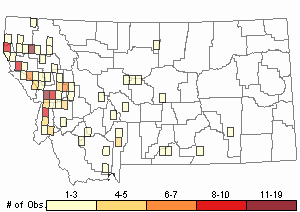View in other NatureServe Network Field Guides
NatureServe
Montana
Utah
Wyoming
Idaho
Wisconsin
British Columbia
South Carolina
Yukon
California
New York
Signal Crayfish - Pacifastacus leniusculus
Native Species
Global Rank:
G5
State Rank:
S5
(see State Rank Reason below)
Agency Status
USFWS:
USFS:
BLM:
External Links
State Rank Reason (see State Rank above)
Even more abundant now than before reserviors were build in the state.
General Description
The signal crayfish, Pacifastacus leniusculus, is an large North American crayfish indigenous to the western United States. Members of this species are up to 15 cm in length. They are bluish-brown to reddish-brown in color with robust large smooth claws. They have a white to pale blue-green patch near the claw hinge (see photo). Like all crayfish, they are solitary and omnivorous, although their diet is mainly vegetarian they will eat anything from decaying roots and leaves to meat, including crayfish smaller than themselves.
Species Range
Montana Range
Range Descriptions

 Native
Native
Range Comments
Confirmed abundant distributions in the Columbia drainges of western MT. Also found in Idaho, Nevada, Oregon, Utah, Washington, and Wyoming. This species has been recently reported in the Missouri River drainages of Montana (ex. East Gallatin, Big Otter Creek) probably from introductions from west to east (Gustafson 2006).
Observations in Montana Natural Heritage Program Database
Number of Observations: 170
(Click on the following maps and charts to see full sized version)
Map Help and Descriptions
Relative Density

Recency



 (Observations spanning multiple months or years are excluded from time charts)
(Observations spanning multiple months or years are excluded from time charts)
Habitat
This crayfish prefers large cobbles or woody debris to hide under, and if softer sediment banks are available will create burrows. It is found in streams to large rivers and is even larger and more abundant in reserviors and lakes along the mainstem Clark Fork river.
Food Habits
This species is omnivorous and a scavenger, feeds by shredding large pieces of orangic materials and shredding them up.
Ecology
Pacifastacus leniusculus is very active and migrates up and down rivers, as well as moving overland around obstacles. However, their rate of colonization is relatively slow and may only be about 1 km yr-1. In one stream in England it took 17 years for them to spread 12 km downstream (Stanton 2004).
Reproductive Characteristics
Pacifastacus leniusculus has a typical life cycle as a member of the crayfish family Astacidae. The eggs hatch into miniature crayfish that stay with the mother for three stages, the third stage gradually becoming more and more independent of the mother. Juveniles undergo as many as 11 moults during their first year, but by age 3 this is reduced to two moults per year, and by age 4 onwards to one moult per year (Lewis and Horton 1996).
Management
Abundant in the Lower Clark Fork and Kootenai Drainages, big harvests have been reported in the Noxon Reservior areas.
Threats or Limiting Factors
No threats to Montana's populations of Pacifastacus leniusculus have been identified, it is an aggressive competitor and has been responsible for displacing indigenous crayfish species wherever it has been introduced.
References
- Literature Cited AboveLegend:
 View Online Publication
View Online Publication Gustafson, D. 2006. Personal communication: Dan Gustafson, Research Scientist Department of Biology Montana State University.
Gustafson, D. 2006. Personal communication: Dan Gustafson, Research Scientist Department of Biology Montana State University. Lewis, S.D. and H.F. Horton. 1996. Life history and population dynamics of the signal crayfish, Pacifastacus leniusculus, in Lake Billy Chinook, Oregon. Freshwater Crayfish 11: 34-53.
Lewis, S.D. and H.F. Horton. 1996. Life history and population dynamics of the signal crayfish, Pacifastacus leniusculus, in Lake Billy Chinook, Oregon. Freshwater Crayfish 11: 34-53. Stanton, J.A. 2004. Burrowing Behaviour and Movements of the Signal Crayfish Pacifastacus Leniusculus (dana). Leicester: University of Leicester.
Stanton, J.A. 2004. Burrowing Behaviour and Movements of the Signal Crayfish Pacifastacus Leniusculus (dana). Leicester: University of Leicester.
- Web Search Engines for Articles on "Signal Crayfish"
- Additional Sources of Information Related to "Crayfish / Amphipods / Pill Bugs"





